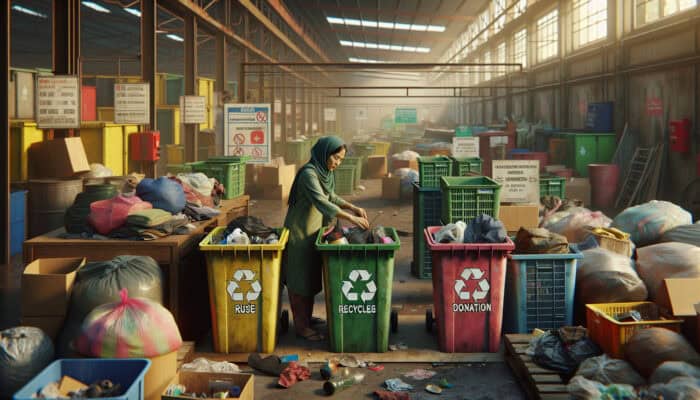Introduction to Green Decluttering
What is Green Decluttering?

Green Decluttering for House Clearance: Green decluttering is more than just a trendy buzzword; it is a conscious approach to clearing out your home while prioritising environmentally friendly methods. This practice focuses on reducing waste and emphasising recycling during house clearance. It’s about making decisions that create a positive impact on both your living space and the planet. Rather than simply tossing unwanted items into the bin, green decluttering encourages you to think critically about where your possessions end up, choosing instead to recycle, repurpose, or donate.
The essence of green decluttering lies in its dual focus: not only do you declutter your physical space, but you also engage in a process that mitigates environmental harm. This practice resonates particularly well in today’s context, where sustainability is not just a fad but a necessary approach to living harmoniously with our surroundings. In the UK, where landfill waste is a pressing issue, adopting green decluttering can make a substantial difference.
Why Choose Green Decluttering?
Choosing green decluttering is a proactive choice that significantly helps the environment. By reducing landfill waste and promoting recycling, you contribute to a healthier planet. More than just an eco-friendly choice, it fosters a lifestyle rooted in sustainability. You become part of a growing movement that seeks to minimise our ecological footprint, ensuring that future generations inherit a planet with better resources and a cleaner environment.
Moreover, green decluttering can be remarkably cost-effective in the long run. By recycling and opting for second-hand items instead of new purchases, you can save money while simultaneously promoting sustainability. You also cultivate a more mindful approach to consumerism, allowing you to make informed decisions about what you own and what you truly need.
Benefits of Green Decluttering
The advantages of green decluttering extend beyond the immediate satisfaction of a tidy home. First and foremost is the reduced environmental impact. By consciously choosing to recycle and donate, you lessen the strain on landfill sites and natural resources. This simple act contributes to a more sustainable future, where every little bit counts.
Another significant benefit is the potential financial savings. Selling or donating items can create financial returns while reducing the need for new purchases. This cycle of reuse and recycling fosters a more sustainable consumer culture. Furthermore, green decluttering encourages a more mindful approach to possessions, prompting you to reflect on what you own and why you own it. This introspection can lead to increased satisfaction and appreciation for the items you choose to keep.
How to Start Green Decluttering

Beginning your green decluttering journey does not need to be overwhelming. Start by sorting your belongings into categories for reuse, recycling, and donation. This method allows for a streamlined approach, making it easier to decide what to do with each item. Research local recycling facilities and charities to ensure your efforts are not only effective but also environmentally friendly. Familiarising yourself with local guidelines can enhance your green decluttering experience.
A common pitfall is the reluctance to part with items. Remember, it’s not about the quantity but the quality of what you retain. Set aside specific times to assess your belongings, and always approach the process with a clear intention. This clarity will guide your decisions and help maintain your commitment to sustainable practices.
Common Mistakes in Green Decluttering
< While green decluttering has many benefits, it’s essential to approach it correctly to maximise its impact. One common mistake is improper recycling. Many people are unaware of local recycling regulations and inadvertently place items in the wrong bins, undermining their efforts. Educating yourself about what can and cannot be recycled in your area will help you avoid this pitfall.
Another mistake is over-donating to charity shops without considering their capacity. Charity shops often struggle with excess donations, which can lead to waste if they cannot sell the items. It’s critical to assess the condition and demand for items before donating. Additionally, many neglect to consider repairs or repurposing, choosing instead to discard items that might still have life left in them. Embracing creative thinking can extend the life of your possessions and enhance your decluttering impact.
Expert Insights on Green Decluttering for House Clearance
How Can Experts Help with Green Decluttering?

Experts in green decluttering can offer invaluable insights and guidance to make your decluttering process more efficient and eco-conscious. They can provide tailored strategies on sorting, recycling, and the best disposal methods for various items. Their experience ensures that your efforts align with best practices for sustainability, therefore maximising your impact on the environment.
Here are some expert tips for green decluttering:
- Evaluate each item for its usefulness and emotional value before deciding its fate.
- Utilise technology to track what you own and identify items you can part with.
- Connect with local environmental groups for recycling and waste disposal information.
- Plan regular decluttering sessions to maintain a clutter-free space.
Experts also emphasise the importance of sharing your goals with family or housemates to ensure everyone is on the same page. This collective effort can lead to a more cohesive approach to maintaining a sustainable home.
What Are the Latest Trends in Green Decluttering?
The landscape of green decluttering is continuously evolving, with several trends gaining traction in the UK. One of the most prominent is upcycling. This creative practice transforms discarded items into something new and useful, allowing you to breathe new life into forgotten treasures. It reflects a shift towards not just disposing of items but finding innovative ways to repurpose them.
Minimalism is another trend that pairs beautifully with green decluttering. This lifestyle advocates for owning fewer possessions, leading to a cleaner, more organised space and reducing the demand for new products. Many UK residents are gravitating towards this philosophy, which encourages not only decluttering but also intentional purchasing.
Technology is also playing a role in green decluttering. Apps that help track possessions and identify items for recycling or donation are becoming increasingly popular. These tools streamline the decluttering process, making it easier to manage your belongings and reduce waste.
Include Real-World Examples of Successful Green Decluttering
Several inspiring case studies in the UK highlight the success of green decluttering initiatives. For example, the city of Bristol has launched numerous community projects focusing on recycling and upcycling, significantly reducing landfill waste. Local workshops teach residents how to transform unwanted furniture into artistic pieces, fostering community spirit and environmental awareness.
Another noteworthy example is London’s campaign promoting ‘swap shops’, where individuals can exchange items they no longer need. These events not only facilitate decluttering but also strengthen community ties while reducing waste. Participants leave with new treasures, often providing a deeper appreciation for their belongings.
These real-world examples illustrate that green decluttering is not just an individual effort but a collective movement. By sharing resources and ideas, communities are driving change toward more sustainable living practices.
How to Start Your Green Decluttering Journey
What Should You Declutter First?
When embarking on your green decluttering journey, it’s wise to start with items that are easier to sort and dispose of. Begin with paper, plastics, and electronics. These categories often have clear recycling channels and can significantly reduce clutter quickly. The immediate results can motivate you to tackle more challenging items later.
Here’s a bullet list of items to declutter first:
- Old newspapers and magazines
- Plastic containers and packaging
- Broken or outdated electronics
- Unwanted clothing and accessories
Focusing on these items not only clears physical space but also sets a tone for your decluttering journey. Once you’ve successfully cleared these areas, you can gradually move on to more sentimental or challenging possessions.
How to Sort and Categorise Items
Effective sorting and categorising are crucial for a successful green decluttering experience. Establish clear categories such as ‘recycle’, ‘donate’, ‘sell’, and ‘keep’. This framework allows you to streamline the decision-making process, ensuring that each item receives the attention it deserves. Take your time with each category, ensuring that you are making thoughtful decisions about what to retain and what to part with.
Consider using bins or boxes labelled with these categories to keep the process organised. As you sort, ask yourself critical questions about each item: When did I last use this? Does it bring me joy? Is it truly useful? This reflective process will help you make more informed choices and enhance your connection to the items you choose to keep.
Tips for Maintaining a Clutter-Free Home
Maintaining a clutter-free home requires commitment and regular effort. One effective strategy is to schedule regular decluttering sessions. Whether it’s monthly or seasonally, setting aside dedicated time ensures that your space remains organised and intentional.
Mindful purchasing plays a significant role in preventing clutter accumulation. Before making any purchases, consider whether the item aligns with your minimalist lifestyle. Ask yourself if it’s a need or a want, and whether it will genuinely enhance your space. This practice fosters a more sustainable relationship with consumerism.
Adopting a minimalist lifestyle can also support your decluttering goals. Embrace the philosophy of quality over quantity, focusing on keeping items that serve both functional and emotional purposes. This intentional approach leads to a more fulfilling living environment and enhances your commitment to sustainability.
How to Dispose of Hazardous Waste Safely
Disposing of hazardous waste safely is a crucial aspect of green decluttering that requires careful consideration. Items such as batteries, paints, and chemicals must be handled appropriately to prevent environmental harm and comply with local regulations. Many local councils offer specific guidelines for hazardous waste disposal, often providing designated drop-off points or collection services.
Before disposing of such items, check the regulations in your area. Familiarise yourself with local hazardous waste facilities, and never throw these items in regular bins as they can contaminate landfills and soil. Proper disposal is not just a legal obligation; it’s a vital part of protecting our environment.
Consider reaching out to local community groups or environmental organisations for additional resources on safe disposal methods. They often have educational materials or programs designed to assist residents in managing hazardous waste responsibly.
The Benefits of Green Decluttering for Mental Health
A cluttered environment can contribute to a sense of overwhelm and stress. By embracing green decluttering, you pave the way for a cleaner, more organised home that can lead to improved mental health. A tidy space fosters clarity, allowing for greater focus and productivity. The act of decluttering itself can be therapeutic, providing a sense of accomplishment and control over your surroundings.
Moreover, a clutter-free environment promotes a healthier lifestyle. The space allows for better organisation, making it easier to maintain cleanliness and reduce allergens. This attention to your physical space can translate into emotional well-being, as you develop a stronger connection to your home.
The process of green decluttering encourages mindfulness, which can reduce anxiety and enhance overall life satisfaction. By consciously choosing what to keep and what to let go, you cultivate a more intentional approach to your living space, ultimately benefiting your mental health.
What Are the Benefits of Green Decluttering?
Environmental Impact of Green Decluttering
Green decluttering has a profound impact on the environment, significantly reducing the ecological footprint of house clearance. By prioritising recycling and reuse, you help minimise landfill waste, which in turn conserves natural resources and reduces pollution. Each item you recycle or donate represents a step towards a more sustainable planet.
The practice of green decluttering contributes to a circular economy, where products are designed to be reused, repaired, and recycled. This approach not only lessens the strain on our environment but also promotes responsible consumption patterns among individuals and communities. Each effort adds up, leading to a collective reduction in environmental degradation.
How Does Green Decluttering Save Money?
Green decluttering can lead to significant financial savings in various ways. First, selling or donating items you no longer need can generate immediate returns. Instead of allowing unused items to gather dust, consider listing them on local marketplaces or donating them to charity shops, creating a win-win situation.
Moreover, maintaining a clutter-free home can prevent unnecessary purchases. With fewer items around, you are more likely to become mindful of what you truly need, leading to fewer impulse buys. This conscious consumer behaviour not only saves money but also promotes a more sustainable lifestyle.
Additionally, recycling can reduce waste disposal costs. Many local councils offer incentives for recycling, allowing you to save on waste collection fees while benefiting the environment. By engaging in green decluttering, you cultivate a more financially sustainable lifestyle.
What Are the Psychological Benefits of Green Decluttering?
The psychological benefits of green decluttering are well-documented. As you clear out your space and maintain an organised environment, you experience a sense of accomplishment that can bolster self-esteem and promote a positive mindset. The act of decluttering can serve as a form of therapy, offering a release from stress and anxiety.
A decluttered space provides clarity, making it easier to focus on tasks and reducing feelings of overwhelm. This newfound mental space often leads to improved productivity and creativity, allowing you to engage more fully in daily activities. Additionally, creating an intentional living space fosters a deeper connection to your belongings, enhancing emotional well-being.
Ultimately, the mental clarity achieved through green decluttering can lead to a more harmonious existence by surrounding yourself with items that truly resonate with and serve you, contributing to a more joyful and fulfilling life.
How Does Green Decluttering Promote Sustainability?
Green decluttering is intrinsically linked to sustainability. By encouraging the reuse and recycling of items, you actively participate in reducing the demand for new products, which conserves resources and mitigates environmental harm. This practice fosters a culture of sustainability that extends beyond individual actions, encouraging collective responsibility for our planet.
As you engage in green decluttering, you model sustainable behaviours for your family, friends, and community, inspiring others to follow suit. This ripple effect can contribute to a broader movement towards more sustainable living practices, reinforcing the importance of mindfulness in consumption.
Moreover, green decluttering aligns with the principles of a circular economy, where the lifecycle of products is extended through reuse and recycling. By embracing this ethos, you contribute to a more sustainable future for generations to come, ensuring that our planet remains vibrant and viable.
What Community Benefits Arise from Green Decluttering?
The community benefits of green decluttering are significant. When individuals donate items to local charities, they support organisations that rely on these donations to fund their missions. This support can be vital for charities, allowing them to provide services and resources to those in need within the community.
Furthermore, green decluttering fosters a sense of communal responsibility and connection. As community members engage in sustainable practices, they create a collective identity centred around environmental stewardship. Community events, such as swap shops or recycling drives, promote collaboration and social cohesion while addressing waste reduction.
By participating in green decluttering initiatives, individuals can also inspire local businesses to adopt more sustainable practices, leading to a broader community shift towards sustainability. This collective effort enhances the overall quality of life, ensuring a healthier environment for everyone.
Research-Backed Benefits of Green Decluttering for House Clearance
What Does Research Say About Green Decluttering?
Research has shown that green decluttering can significantly reduce environmental impact and promote sustainable living. Numerous studies highlight the positive effects of recycling and reusing items during house clearance, illustrating how these practices contribute to a healthier planet. By embracing green decluttering, individuals can play a vital role in mitigating the environmental crisis.
Beyond environmental considerations, research also points to the psychological benefits that come with decluttering. Individuals who engage in green decluttering report higher levels of satisfaction and well-being, indicating a strong link between organisation, mindfulness, and mental health. This body of evidence reinforces the importance of adopting sustainable practices not only for the environment but also for personal fulfilment.
How Can Green Decluttering Improve Your Life?
Green decluttering can transform your life in numerous ways. By fostering a more sustainable lifestyle, you create a positive impact on the environment while enhancing your personal well-being. As you reduce clutter, you cultivate a sense of organisation and control in your living space, leading to reduced stress and anxiety.
This practice encourages mindful consumption, prompting you to make intentional choices about what you allow into your home. By focusing on quality over quantity, you develop a deeper appreciation for your belongings, leading to a more fulfilling and harmonious living environment. Ultimately, green decluttering is a pathway to a more meaningful life, where every choice reflects your values and aspirations.
Provide Actionable Steps for Implementing Green Decluttering
Implementing green decluttering in your home can be straightforward and rewarding. Begin by setting clear intentions for your decluttering journey. Identify specific areas or categories you wish to tackle first, such as your wardrobe or kitchen.
Next, follow these actionable steps to enhance your green decluttering efforts:
- Sort items into categories: recycle, donate, sell, and keep.
- Research local recycling facilities and charities to understand their processes.
- Schedule regular decluttering sessions to maintain organisation.
- Encourage family members to participate in the decluttering process.
By taking these steps, you ensure that your green decluttering journey is both effective and sustainable. Each action contributes to creating a more organised home while positively impacting the environment.
Trusted Strategies for Green Decluttering for House Clearance
What Are the Most Effective Green Decluttering Strategies?
Implementing effective green decluttering strategies is essential for a successful house clearance. Start by categorising items to streamline the process. Sorting belongings into ‘recycle’, ‘donate’, ‘sell’, and ‘keep’ ensures that each item is thoughtfully considered and appropriately handled.
Utilising local recycling facilities is paramount. Familiarise yourself with your local council’s guidelines on recycling, and take advantage of community programmes that promote waste reduction. Additionally, consider donating usable items to local charities, helping those in need while reducing landfill waste.
Here are some effective strategies for green decluttering:
- Regularly assess your belongings to prevent clutter accumulation.
- Engage in community recycling initiatives to promote sustainability.
- Opt for sustainable disposal methods for hazardous materials.
- Encourage friends and family to join your green decluttering efforts.
These strategies not only enhance your own decluttering experience but also contribute to a broader culture of sustainability within your community.
How Can You Ensure Your Decluttering is Truly Green?
To ensure that your decluttering efforts are genuinely green, it’s crucial to research local recycling options thoroughly. Understand what materials can be recycled in your area and ensure that you are following the correct protocols. This diligence helps minimise the chances of contamination, which can lead to more waste being sent to landfills.
Choose sustainable disposal methods for items that cannot be recycled. Consider composting organic waste or donating usable items to charitable organisations. Additionally, avoid unnecessary purchases that contribute to waste, as this mindset fosters a more sustainable lifestyle. By being mindful of your choices, you can maintain a green decluttering ethos long after your initial clearance.
Offer Expert Analysis on Green Decluttering Techniques
Expert analysis of green decluttering techniques reveals that successful decluttering hinges on thoughtful organisation and sustainability practices. Experts often recommend starting small, focusing on specific areas within your home to avoid feeling overwhelmed. This approach allows you to build momentum and confidence as you see results.
Additionally, employing technology to track your possessions can provide insight into what you own and help identify items to part with. Many apps assist in inventory management and can even suggest recycling options based on the items you wish to discard.
Case studies of successful green decluttering initiatives across the UK highlight the importance of community engagement and education. Many local councils offer workshops and resources focused on sustainable practices, encouraging residents to adopt green decluttering as a lifestyle choice. By following these expert insights, you can enhance your green decluttering journey and contribute positively to your environment.
Resources and Support for Green Decluttering in the UK
Where to Find Green Decluttering Resources
Numerous resources are available in the UK to support your green decluttering journey. Online guides provide valuable information on best practices for decluttering and recycling. Websites like Recycle Now and local council pages often feature comprehensive resources on recycling facilities, collection dates, and donation opportunities.
Additionally, community centres frequently host workshops focused on sustainable living and decluttering techniques. Engaging with local environmental groups can also connect you with like-minded individuals who share your commitment to sustainability. These networks often provide opportunities for collaboration and support in your decluttering efforts.
How Can Local Communities Support Green Decluttering?
Local communities play a crucial role in supporting green decluttering initiatives. By providing accessible recycling facilities and hosting events such as swap shops or clean-up days, communities can foster a culture of sustainability. These events encourage residents to participate in decluttering efforts while reinforcing the importance of reducing waste.
In addition, community outreach programmes can educate residents about recycling options and sustainable practices. Schools, libraries, and community centres often serve as hubs for information dissemination, promoting awareness of environmentally friendly behaviours. By supporting these initiatives, communities contribute to a collective effort towards sustainability and responsible waste management.
What Government Initiatives Support Green Decluttering?
The UK government offers various initiatives that support green decluttering, reflecting its commitment to environmental sustainability. Recycling programmes at the local level are designed to encourage residents to recycle more effectively, often accompanied by public information campaigns about waste reduction.
Additionally, grants and funding opportunities for sustainable living projects are available, supporting community-based initiatives focused on reducing waste and promoting greener practices. The government’s commitment to a circular economy further underscores the importance of sustainable consumption, aligning perfectly with the principles of green decluttering.
FAQs
What is green decluttering?
Green decluttering is the practice of clearing out your home while focusing on environmentally friendly methods, such as recycling and donating, to minimise waste and promote sustainability.
How can I start green decluttering?
Begin by sorting your items into categories: recycle, donate, sell, and keep—research local recycling facilities and charities to understand how to dispose of items responsibly.
What are the benefits of green decluttering?
Benefits include reduced environmental impact, potential savings through recycling, a sense of accomplishment, and improved mental well-being from a clutter-free space.
How does green decluttering promote sustainability?
It promotes sustainability by encouraging the reuse and recycling of items, thereby reducing the demand for new products and conserving natural resources.
What should I declutter first?
Start with items that are easy to sort, such as paper, plastics, and electronics, which can often be recycled or donated to local charities.
How do I dispose of hazardous waste safely?
Research local regulations for hazardous waste disposal. Many councils have designated drop-off points or collection services for items like batteries and chemicals.
What are some common mistakes in green decluttering?
Common mistakes include improper recycling, over-donating to charity shops, and neglecting to repair or repurpose items rather than discarding them.
How can I maintain a clutter-free home?
Schedule regular decluttering sessions, practice mindful purchasing, and embrace a minimalist lifestyle to keep your home organised and clutter-free.
What expert tips can help with green decluttering?
Experts recommend evaluating the usefulness of items, using technology to track possessions, and engaging family members in the decluttering process for a collective effort.
How does green decluttering affect mental health?
It can lead to reduced stress, improved focus, and a sense of accomplishment, contributing to overall mental well-being and a healthier living environment.






